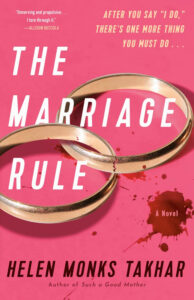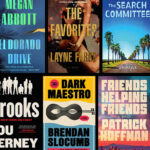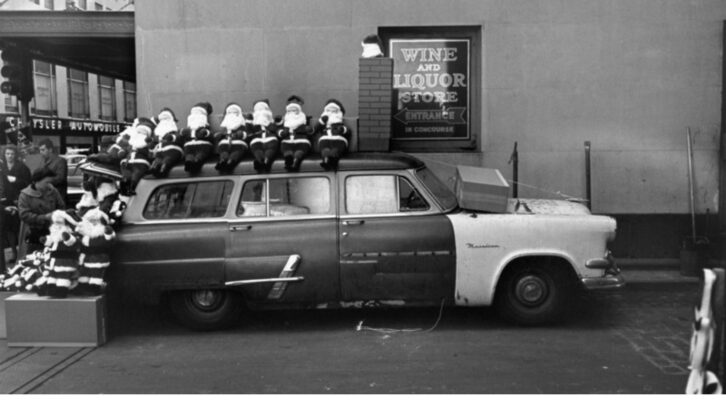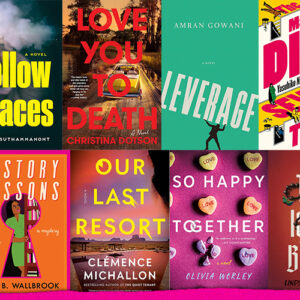Lies, revenge, murder. Why is it when the perpetrators are a couple, the sum of darkness generated is greater than its two contributing parts? The bedrock of romantic love is two people connecting through emotional honesty and trust. When writers twist these foundations, emotional honesty means finding someone to whom you can finally reveal your bleakest predilections or deepest shame. Trust means having faith your partner won’t tell; they may even enable you.
Elle and Dom, the central couple in my latest thriller, The Marriage Rule, appear to most of the world an enviable couple. Elle has an adorable baby girl, and an adoring husband, someone she can turn to when she needs to extract herself from a murder scene, one she’s apparently created.
I realized, as I wrote the story, how convincingly a married couple, and a marriage itself, can either obscure crimes from public view or allow wrongs to hide in plain sight. Does Elle’s determination to please Dom speak of devotion or terror? Does Dom’s commitment to supporting Elle in her darkest hour show the greatest care or dark control?
The collision of criminality and coupledom in fiction has long made misdemeanours more subversive than those executed by a single culprit. ‘Stars, hide your fires/Let not light see my black and deep desires.’ While Macbeth wishes the cosmos ignorance of his ambitions to be King of Scotland, his wife knows all. Lady Macbeth stokes her husband’s worst instincts, inciting him to murder to take the throne. The pair are the original couple who kill. They pave the way for the archetype of the driven, scheming wife and the morally uncertain husband, deployed to dazzling effect in in Samantha Downing’s barnstorming 2019 thriller My Lovely Wife.
While the couple’s kills are orchestrated and executed by the pair, it’s Millicent who dominates proceedings. ‘Her eyes are green, many shades of green, and they look like camouflage,’ so says her enthralled, nameless husband.
The novel crackles with the marriage’s sick energy, as they select their victims and the husband narrator looks back at the genesis of his relationship with Millicent, peeling back her layers, before she frames him for being a lone serial killer.
‘If we do this right…the police will never even think to look for a couple. We’ll be free to do whatever we want,’ Millicent tells her husband near the start of the story. For a time, the same principle applies to Carl and Sandy Henderson, the serial-killing couple in Donald Ray Pollock’s chilling exploration of sin and trauma in post-war, rural Ohio, The Devil All The Time (2011).
In one strand of this gothic crime epic, we meet a psychotic couple masquerading as regular smalltown sweethearts. The pair pick up their hitchhiker prey, rape, murder and mutilate them. Much of the profoundly grisly action is caught on camera by Carl.
The reader is invited to consider whether they could carry out their killing sprees alone – Sandy may experience a guilt that Carl doesn’t and there is some coercion by the husband of the pair, but it’s Sandy who lures their ‘models’ to their deaths and her corrupt sheriff brother who facilitates their unchecked reign of terror.
But it’s not only murder that couples may mask more readily than singletons. In Kia Abdullah’s knotty neighborhood noir Those People Next Door/Perfectly Nice Neighbors (2023) the weaponized defensiveness and out-and-out prejudice of White English couple Tom and Willa is the transgression that propels the plot forward. In a novel of morally complex couples, events escalate after Tom ‘accidentally on purpose’ ensures a Black Lives Matter banner is no longer on display in their British Bangladeshi neighbors’ Salma and Bil’s front garden. The gesture feels like an externalization of the couple’s passive aggression, one that barely hides the deeply held hostility Tom and Willa have for their neighbours.
When your other half facilitates, rather than keeps in check, your worst character traits, wrongdoings are both more likely to happen and be viewed by our dysfunctional couples as right and valid. Tom and Willa reframe their intolerance as somehow the fault of their targets, with Tom telling Salma as the war begins in earnest, ‘You really love playing the victim,’ while later in the novel, Willa tells her, ‘Jesus, you like being angry, don’t you?’
Finally, the transgressive partnership in Sarah Waters superb Fingersmith (2002), a crime story set in Victorian London, represents a different take. Sue and Maud are the pawns in a plot to profit from an elaborate double-crossing scheme. Their misdemeanour in the context of the era and the scheme is to fall in love.
***


















